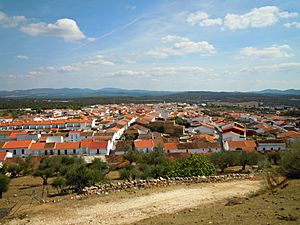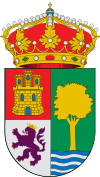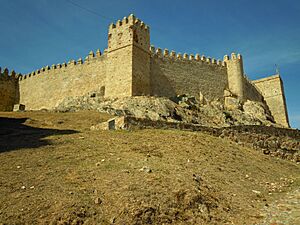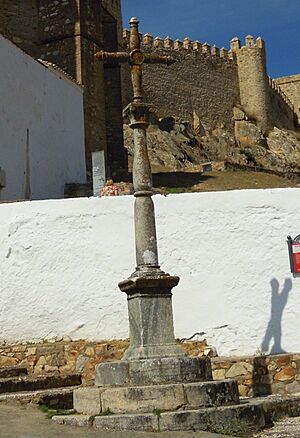Santa Olalla del Cala facts for kids
Quick facts for kids
Santa Olalla del Cala
|
|||
|---|---|---|---|

Santa Olalla del Cala
|
|||
|
|||
| Country | Spain | ||
| Autonomous community | Andalusia | ||
| Province | Huelva | ||
| Comarca | Sierra de Huelva | ||
| Area | |||
| • Total | 204 km2 (79 sq mi) | ||
| • Land | 204 km2 (79 sq mi) | ||
| • Water | 0.00 km2 (0 sq mi) | ||
| Elevation | 535 m (1,755 ft) | ||
| Population
(2018)
|
|||
| • Total | 2,004 | ||
| • Density | 9.824/km2 (25.44/sq mi) | ||
| Time zone | UTC+1 (CET) | ||
| • Summer (DST) | UTC+2 (CEST) | ||
| Website | www.santa-olalla-del-cala.es | ||
Santa Olalla del Cala is a charming village located in the southern part of Spain. It's found in the region of Andalusia and is part of the Huelva province. The village is about 70 kilometers (43 miles) north of the big city of Seville. It's also close to a major road, the A66-E803 motorway, which connects Seville to Salamanca.
Santa Olalla del Cala is known for its beautiful natural surroundings and its historic castle. It's a great place to learn about Spanish history and enjoy the outdoors.
Contents
Where is Santa Olalla del Cala Located?
This village sits on the southern slopes of the Sierra Morena mountains. It's very close to the border between the regions of Andalusia and Extremadura. Santa Olalla del Cala is also inside the Aracena Natural Park. This park is a special protected area that covers the northern part of the Huelva province.
The village is built on the side of a hill. At the very top of this hill, you'll find a historic castle and a church. This church has been used as a Jewish synagogue and a Moorish Mosque in the past. The area around the village is full of green meadows and small hills. You'll see many oak and chestnut trees. Lots of small streams flow through the land, making it a truly beautiful place.
What is the Local Economy Like?
The main way people make a living in Santa Olalla del Cala is through farming. They grow olives and raise Holm Oak trees. These trees are important for feeding Iberian pigs. The village is also famous for its crafts. People here make things from cork and wood. They also create beautiful embroidery and crochet items.
Other jobs in the village include buying and selling goods in shops. People also build houses and work with cars and motorbikes. A big part of the local food is made from the special Iberian pigs. Santa Olalla's delicious sausages are a very popular local food.
Exploring the Castle of Santa Olalla
The castle stands proudly on a rocky ridge above the village. Even though its walls look like those of old Moorish castles, it was actually built by a Christian king. King Sancho IV of Castile built it in the 1200s. It replaced a smaller fort that Muslim rulers had built before. People think the Muslim fort was built on top of an even older Roman one.
This castle was part of a defense system called the Banda Gallega. This system protected the city of Seville from attacks, especially from Portugal. It used three lines of defense, often reusing older Moorish forts. Santa Olalla del Cala's castle was in the third line of these defenses.
How Was the Castle Built?
The castle is made from strong stone and brick. Its outer walls have ten towers. Four of these towers are round, and six are rectangular. The towers are solid and reach the height of the main wall. They have special rooms inside and battlements on top. The castle's inner area has an unusual shape. It follows the natural shape of the hill's top. There's also a unique entrance tower on the northwest side.
What Happened to the Castle Later?
After the castle was no longer needed for defense, it was used for other things. In the 1800s and early 1900s, the castle grounds were used as the village cemetery. Holes were even made in the walls for burials. This sadly made the castle weaker. In 1949, the castle was recognized as an important cultural site. Steps were then taken to protect and preserve it.
The Church of Nuestra Senora de la Asuncion
The Church of Nuestra Senora de la Asuncion is at the southern end of the castle hill. This church has a long history, dating back to the 800s. In the 900s, it was a synagogue and part of the Jewish area of the village. You can still see two columns from that time inside the church.
When Muslims ruled the area, the building became a mosque. The back part of the church still shows its Mudejar style. This style includes brick arches and vaults. Inside the Christian church, you can see a beautiful Gothic doorway. There's also a statue of the Virgin de los Dolores. This statue was carved by a famous Spanish artist, Juan de Mesa y Velasco.
Interestingly, the church also keeps a ship's anchor. This anchor is there to remember a time during the Napoleonic wars. Santa Olalla was a base for a special group of soldiers called maritime infantry back then.
The Pilgrimage Cross
Just outside the church, a little down the hill, stands a 16th-century cross. This cross is in the Plateresco style. It was put there to mark the "Silver Way" (or Vía de la Plata). This is a famous pilgrimage route. Pilgrims used this path to travel from Seville to Santiago de Compostela. The marker has a special column topped with a capital. On top of that sits the Plateresque flint cross.
Population of Santa Olalla del Cala
The number of people living in Santa Olalla del Cala has changed over the years. Here's a look at the population from 1999 to 2005:
- 1999: 2297 people
- 2000: 2244 people
- 2001: 2203 people
- 2002: 2192 people
- 2003: 2173 people
- 2004: 2176 people
- 2005: 2143 people
Images for kids
See also
 In Spanish: Santa Olalla del Cala para niños
In Spanish: Santa Olalla del Cala para niños










